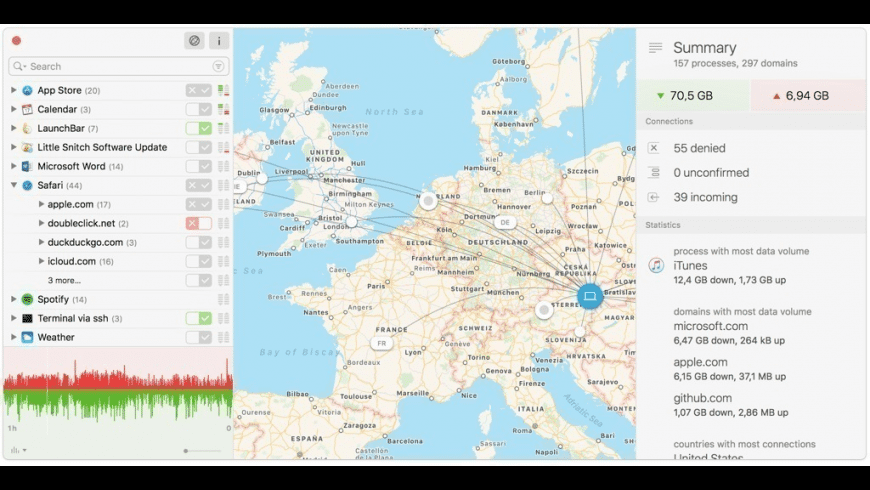| Developer(s) | Objective Development Software GmbH |
|---|---|
| Stable release | 4.5 (March 30, 2020; 19 days ago[1]) [±] |
| Written in | Objective-C |
| Operating system | macOS |
| Available in | German, English, Chinese, Japanese, Russian |
| Type | Firewall |
| License | Proprietary |
| Website | https://obdev.at/products/littlesnitch |
| Usage | |
- Little Snitch Mac
- Little Snitch Alternative
- Little Snitch For Pc
- Little Snitch Discount
- Little Snitch Sale
- Little Snitch Promo 2015 Youtube
Little Snitch is a host-based application firewall for macOS. It can be used to monitor applications, preventing or permitting them to connect to attached networks through advanced rules. It is produced and maintained by the Austrian firm Objective Development Software GmbH.
- Little Snitch. 1,267 likes 4 talking about this. Protect your privacy! Little Snitch informs you whenever a program attempts to establish an outgoing Internet connection and hence reliably prevents.
- Mar 10, 2013 I probably use Little Snitch more than any other application on my computer. So having it on my new iPad was the first thing I thought about after I purchased it. Especially since there are NO LAWS prohibiting anyone from doing anything with the information they collect from all those cookies.
- Jan 03, 2016 Little Snitch 3.6.1 Little Snitch 3.6.1 Final is a powerful firewall for Mac PCs and a useful incoming/outgoing traffic tracking tool. Packages that use the net connection regularly send to special sorts of network facts. Little Snitch lets in you to locate unauthorized connection attempts-oriented tool is for outbound visitors.
Unlike a stateful firewall, which is designed primarily to protect a system from external attacks by restricting inbound traffic, Little Snitch is designed to protect privacy by limiting outbound traffic.[2] Little Snitch controls network traffic by registering kernel extensions through the standard application programming interface (API) provided by Apple.[3]
Apr 01, 2020 Little Snitch now ships with built-in Internet Access Policy information for further macOS system components. Improved selection of relevant information from Internet Access Policy in Network Monitor. Updated Welcome Window in Little Snitch Configuration to reflect the new design of the connection alert.
If an application or process attempts to establish a network connection, Little Snitch prevents the connection. A dialog is presented to the user which allows one to deny or permit the connection on a one-time or permanent basis. The dialog allows one to restrict the parameters of the connection, restricting it to a specific port, protocol or domain. Little Snitch's integral network monitor allows one to see ongoing traffic in real time with domain names and traffic direction displayed.

The application (version 4) received a positive 4.5/5 review from Macworld.[4]
Little Snitch Mac
References[edit]
- ^'Release Notes – Little Snitch'. Retrieved March 31, 2020.
- ^'Little Snitch 4'. Retrieved July 20, 2019.
- ^Little Snitch 3 - Documentation. Objective Development Software GmbH. 2013.
- ^Fleishman, Glenn (September 8, 2017). 'Little Snitch 4 review: Mac app excels at monitoring and controlling network activity'. Macworld. Retrieved July 20, 2019.
Little Snitch Alternative
External links[edit]
- Official website
Little Snitch For Pc
Little Snitch Discount
Bartender app mac free software.
Little Snitch Sale
Retrieved from 'https://en.wikipedia.org/w/index.php?title=Little_Snitch&oldid=929591356'
Little Snitch Promo 2015 Youtube
- How to block Little Snitch from calling home and killing numbers:
- 1. The first step is to block Little Snitch with Little Snitch. Create two new rules in Little Snitch as below:
- a) Deny connections to Server Hostname http://www.obdev.at in LS Configuration. The address that will appear if you do it correctly is 80.237.144.65. Save.
- and the next is:
- b) Deny connections in LS Config to the application Little Snitch UIAgent (navigate to /Library/Little Snitch/Little Snitch UIAgent.app, any server, any port.
- 2. After that is done, open the Terminal (in your Utilities) and paste in:
- sudo /Applications/TextEdit.app/Contents/MacOS/TextEdit /etc/hosts
- (Hit return and type in your admin password). A TextEdit window will open behind the Terminal window. Command+Tab to it - this is your hosts file.
- 3. Place your cursor at the end of the text there, type or leave one vertical space and paste in the following:
- # Block Little Snitch
- 4. Close TextEdit, hit Command+Tab to return to the Terminal window, and paste in the following:
- sudo dscacheutil -flushcache
- 5. Hit the Return key and quit Terminal. You're finished now.
- 6. Easy, isn't it. If only everyone would do this, the developer would cease and desist from killing the number that you personally are using successfully on your Mac. At least until the next version is released…